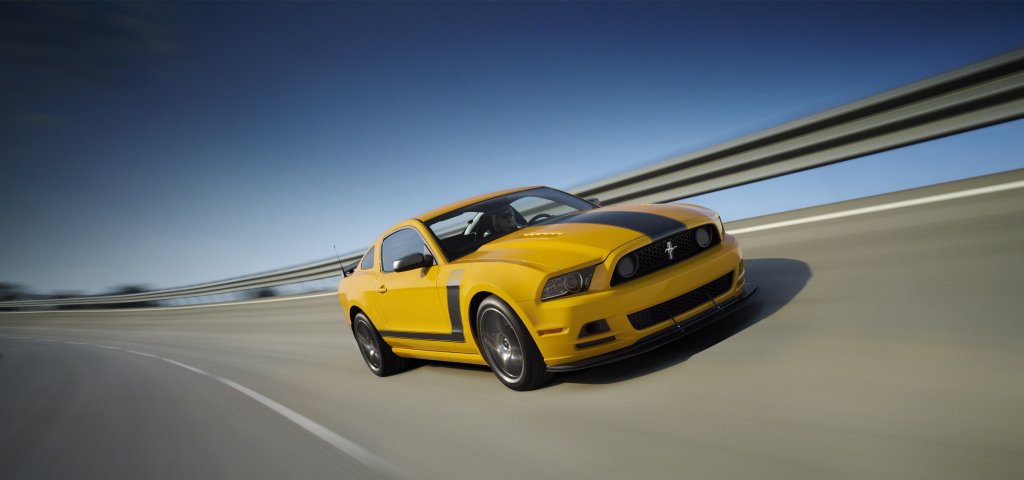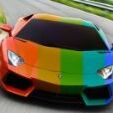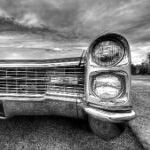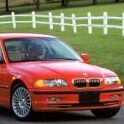
The Mustang Boss 302 is seeing some minor changes for the LA Show Show this week. Alongside the changes for the exterior for the Mustang, the Boss 302 and Laguna Seca models get a new School Bus Yellow exterior paint color and a "hockey stick" stripe package recalling the 1970 Mustang Boss 302. The Boss 302 Laguna Seca will add Sterling Gray exterior accents and two-tone gray and silver wheels.
The Boss 302 also gets some new options including a Torsen limited-slip differential and Recaro seats.
Press Release is on Page 2
Ford Mustang Boss 302: Back with More for 2013, Paying Homage to a ’70s Legend
- 2013 Ford Mustang Boss 302 builds on the heritage of the 1970 Boss 302 with new, reflective hockey stick graphics package – first modern application on a production car
- Also new for 2013 is heritage-inspired School Bus Yellow paint and Sterling Gray accents on Boss Laguna Seca, which delivers race-ready suspension, aerodynamic details and removed rear seat
- Ford SYNC® connectivity system becomes a standard Boss feature for 2013, adding to a specially tuned engine, quad exhaust, brakes, suspension and design that optimize weight, aerodynamics and track performance
LOS ANGELES, Nov. 15, 2011 – The Ford Mustang Boss 302 is all about performance, and a nod to heritage comes standard with new paint options and design details for 2013.
A new hockey stick graphic featuring reflective stripes is added to the new Boss, calling back the 1970 Boss 302. 2013 Boss 302 and Boss Laguna Seca models feature new School Bus Yellow paint, honoring Parnelli Jones’ 1970 Trans-Am championship car prepared by Bud Moore.
“Everything we did for 2013 is consistent with and links directly back to our 1970 heritage. The reflective stripes and hockey stick graphic in particular mean something to Mustang enthusiasts,” said Dave Pericak, Mustang chief engineer. “Last year, we proved the car had what it takes to perform, and this year we focused on enhancing its eye-catching looks and celebrating its history.”
The reflective stripes on Boss come to life when lights hit them, similar to how they did in 1970 on the Mustang Boss 302. The new stripe follows the classic hockey stick motif by going over the fender and extending down the body panel.
Boss Laguna Seca has new Sterling Gray accents and will be available in vintage School Bus Yellow and black paint offerings, complemented by hockey stick stripes and gray interior rear cross-brace. Gray also sets off the front grille, mirror caps and rear pedestal spoiler, while Laguna Seca rear badging and unique two-tone gray and silver wheels round out the exterior accents. Unlike the previous model, the roof will not feature colored accents.
Similar to the redesigned base Mustang lineup, the front end offers a more powerful design with a more prominent grille. A more powerful splitter and functional hood extractors add to that look. Boss Mustang has new signature lighting, with standard HID headlamps and LED-surround taillamps.
The 2013 Boss also offers a unique functional design feature in the grille with removable covers where fog lamps would be. For improved cooling on track days, the covers can be easily removed with a screwdriver.
Additionally, the rear end features a high-gloss black panel that connects the taillamps. The taillamps deliver a smoked appearance that matches up with the sinister look up front.
The new Mustang Boss includes Ford SYNC®, the voice-activated in-car connectivity system, as a standard feature. With the base SYNC package, customers enjoy the core hands-free features and services that have quickly established SYNC as a must-have technology, with more than 76 percent of current SYNC users saying they would recommend the system to others.
Some features of SYNC include:
- Hands-free, voice-activated calling via a Bluetooth®-connected mobile phone and control of a USB-connected digital music player
- 911 Assist™, the automated emergency calling service that is free for the life of the vehicle
- Vehicle Health Report, the on-demand diagnostic and maintenance information service
Revved up and ready
The powerful Boss engine yields 444 horsepower and 380 lb.-ft. of torque, while still offering a smooth idle and low-end torque for comfortable around-town driving. A race-inspired clutch with upgraded friction materials transmits power, while a short-throw, close-ratio six-speed manual handles gear change duties.
Power is delivered to a 3.73-ratio rear axle using carbon fiber plates in the limited-slip differential to improve handling and longevity. For those who want even more precise control over power delivery, a torque-sensing (Torsen) limited-slip differential is available, coupled with Recaro® front seats.
In keeping with the Boss mandate to provide the best-handling Mustang ever, the already strong Mustang GT suspension system has been further refined. Higher-rate coil springs on all four corners, stiffer suspension bushings and a larger-diameter rear stabilizer bar all contribute to the road racing mission, and Boss models are lowered by 11 millimeters in front and 1 millimeter at the rear versus Mustang GT. But the real key to handling is in the adjustable shocks and struts, standard on all Boss Mustangs.
Working in concert with the suspension upgrades, Boss 302 receives unique, lightweight 19-inch black alloy racing wheels in staggered widths: 9 inches in front, 9.5 inches in the rear. The Pirelli PZero summer tires are sized specifically for each end of the car, with the front wheels receiving 255/40ZR-19 tires while the rear stays planted thanks to 285/35ZR-19 rubber.
Boss braking is also up to the challenge, using Brembo four-piston calipers acting on 14-inch vented rotors up front. In back, standard Mustang GT brakes are upgraded with a Boss-specific high-performance pad compound. The combination of vented brake shields and unique Anti-Lock Brake System (ABS) tuning gives Boss drivers maximum control and rapid, repeatable fade-free stops in road and race situations alike.
Boss 302 circa 1969-70
With styling tweaked by newly arrived Ford designer Larry Shinoda, the new-for-1969 Boss 302 sported front and rear spoilers, blacked-out hood treatment and racy side stripes for a look that screamed performance.
Beyond the bodywork, the Boss 302 didn’t disappoint. Its engine combined a four-bolt main Windsor small-block with reworked heads from the then-new 351 Cleveland engine. A forged steel crankshaft, connecting rods and pistons rounded out the reciprocating assembly. The result was a free-breathing, high-revving powerplant making what Ford claimed was 290 gross horsepower – though actual output is estimated to be significantly higher.
Ford engineers also thoroughly massaged Mustang’s suspension in an effort to meet then-boss Semon “Bunkie” Knudsen’s mandate “to build absolutely the best-handling street car available on the American market.” Stiffer springs and shocks, special sway-bar tuning, a stiffened chassis and wide tires led to the fastest Mustang ever to lap the Ford test track up to that point.






-3707742431.jpg.06edf8e14f4ccf35c60d4774a543cc11.jpg)


Recommended Comments
There are no comments to display.
Join the conversation
You can post now and register later. If you have an account, sign in now to post with your account.
Note: Your post will require moderator approval before it will be visible.